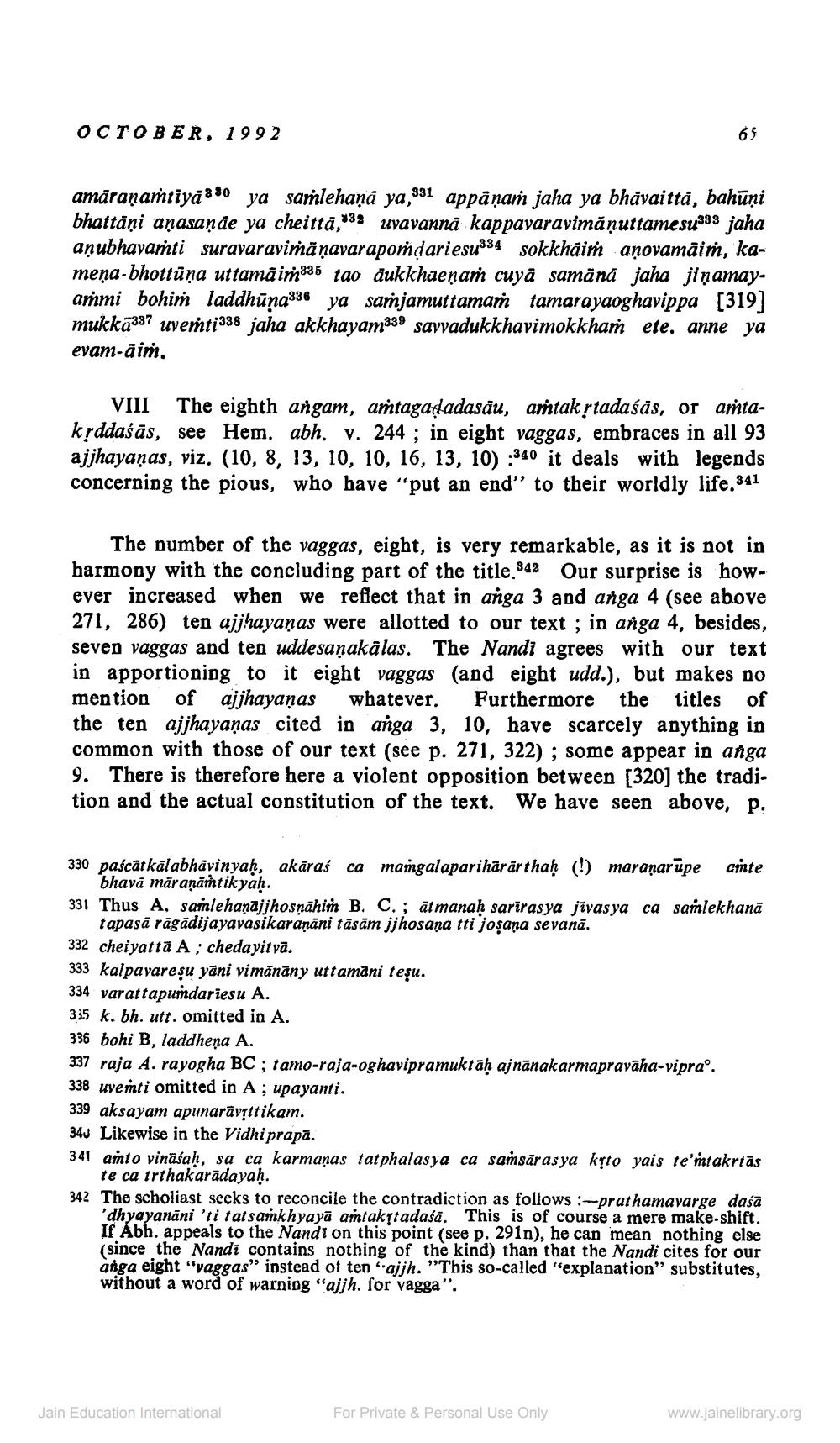________________
OCTOBER, 1992
amāraṇamtiyā 330 ya samlehaṇā ya,3 331 appāņam jaha ya bhavaitta, bahūņi bhattāṇi aṇasaṇāe ya cheittä, uvavannā kappavaravimāṇuttamesu333 jaha anubhavaṁti suravaraviṁāṇavarapomḍariesu334 sokkhaiṁ anovamaiṁ, kameṇa-bhottūṇa uttamāiṁ335 tao āukkhaeṇaṁ cuyā samānā jaha jiņamayammi bohim laddhūṇa336 ya saṁjamuttamam tamarayaoghavippa [319] mukka337 uvemti338 jaha akkhayam339 savvadukkhavimokkham ete, anne ya evam-āim.
VIII The eighth angam, amtagaḍadasău, aṁtakṛtadaśās, or aṁtakṛddaśās, see Hem. abh. v. 244; in eight vaggas, embraces in all 93 ajjhayaņas, viz. (10, 8, 13, 10, 10, 16, 13, 10) :340 it deals with legends concerning the pious, who have "put an end" to their worldly life.341
The number of the vaggas, eight, is very remarkable, as it is not in harmony with the concluding part of the title.342 Our surprise is however increased when we reflect that in anga 3 and anga 4 (see above 271, 286) ten ajjhayaṇas were allotted to our text; in anga 4, besides, seven vaggas and ten uddesaṇakālas. The Nandi agrees with our text in apportioning to it eight vaggas (and eight udd.), but makes no mention of ajjhayaṇas whatever. Furthermore the titles of the ten ajjhayanas cited in anga 3, 10, have scarcely anything in common with those of our text (see p. 271, 322); some appear in anga 9. There is therefore here a violent opposition between [320] the tradition and the actual constitution of the text. We have seen above, p.
330 paścätkalabhāvinyaḥ, akaraś ca mamgalaparihär är thaḥ (!) maraṇarūpe cmte bhavā māraṇāmtikyah.
331 Thus A. samlehaṇajjhosṇahim B. C.; atmanaḥ sarirasya jivasya ca saṁlekhanā tapasā rāgādijayavasikaraṇāni tāsām jjhosana tti joṣaṇa sevanā.
332 cheiyatta A; chedayitva.
333 kalpavare şu yani vimänäny uttamani teşu.
334 varattapumdariesu A.
335 k. bh. utt. omitted in A.
65
336 bohi B, laddhena A.
337 raja A. rayogha BC; tamo-raja-oghavipramuktaḥ ajnanakarmapravaha-vipra°.
338 uvemti omitted in A; upayanti.
339 aksayam apunaravṛttikam.
34J Likewise in the Vidhiprapā.
341 amto vinaśaḥ, sa ca karmanas tatphalasya ca samsarasya kṛto yais te'mtakrtas te ca trthakaradayaḥ.
342 The scholiast seeks to reconcile the contradiction as follows:-prathamavarge dasa 'dhyayanani 'ti tatsamkhyaya amtakṛtadaśā. This is of course a mere make-shift. If Ábh. appeals to the Nandi on this point (see p. 291n), he can mean nothing else (since the Nandi contains nothing of the kind) than that the Nandi cites for our anga eight "vaggas" instead of ten "ajjh. "This so-called "explanation" substitutes, without a word of warning "ajjh. for vagga".
Jain Education International
For Private & Personal Use Only
www.jainelibrary.org




